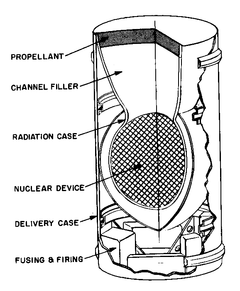To: GonzoGOP
I don’t know how the nuclear explosion thing would work in space without air or medium to get super heated to “push” the ship up to speed. The orion drive uses sequential explosions of Nukes to ‘push’ the ship but with nothing to heat up in space to create a shock wave to further propel the ship, how dose such a drive work? Is it the quick flashes of light and radiation from the nuke fireballs pushing against the shieded drive plate over a period of years even decades, that they expect to provide the momentum?
Drive lasers and concentrated beams of charged particles operating continuously over months might be a better bet as while the initial accelation forces are small, overtime the craft will attain enormous velocities at “c” or close to it since acceleration, while tiny in force is continous until the whole craft is traveling as fast as the photons leaving the drive engines.
18 posted on
12/19/2012 9:14:05 AM PST by
mdmathis6
("Barry" Xmas to all and have a rapaciously taxable New Year!)
To: mdmathis6
I don’t know how the nuclear explosion thing would work in space without air or medium to get super heated to “push” the ship up to speed.
These are not your run of the mill H-bombs. The bomb's geometry and materials focused the X-rays and plasma from the core of nuclear explosive to hit the reaction mass. A bomb with a cylinder of reaction mass expands into a flat, disk-shaped wave of plasma when it explodes. A bomb with a disk-shaped reaction mass expands into a far more efficient cigar-shaped wave of plasma debris. The cigar shape focuses much of the plasma to impinge onto the pusher-plate.
In effect each bomb would be a nuclear shaped charge. The propellant medium is partially provided by the material of the explosive itself converted to extremely hot plasma by the explosion. However the majority of the plasma is created by a cone of plastic which not only is converted to plasma, but does not become radioactive like a metallic filler would. Some of the original designs used tungston because it gave more thrust, but it also would have been expensive and more importantly created a vast amount of fallout from the launch.

19 posted on
12/19/2012 10:58:14 AM PST by
GonzoGOP
(There are millions of paranoid people in the world and they are all out to get me.)
To: mdmathis6
Drive lasers and concentrated beams of charged particles operating continuously over months might be a better bet as while the initial acceleration forces are small, overtime the craft will attain enormous velocities at “c” or close to it since acceleration, while tiny in force is continuous until the whole craft is traveling as fast as the photons leaving the drive engines.
There are two problems with the drive lasers. First you have to build them, and that isn't something we know how to do. They require vast amounts of orbital infrastructure (in contrast a city sized Orion could be surfaced launched if you can get it past the EPA). Finally in order to decelerate you need drive lasers on the other end.
Stopping an Orion wouldn't be easy either. Nuclear bombs have a use by date, and after a few hundred years they aren't going to go bang any more. So the ship would need to have some way of reprocessing the tritium pits used to detonate the bombs used for the deceleration phase. A NSW engine would work for deceleration. The problem with those isn't getting them going, it is keeping them under control. If any of the fuel leaks it immediately goes critical. When you remember that we are talking about a corrosive liquid that you need to store for four centuries the problem starts to become clear.
A beamed energy craft may be the answer to intersteller colonization as their top speed is vastly higher than a nuclear salt-water rocket or Orion drive. The top end is actually limited to less than .5 c because since the photon is only going at c it hits with less force as the ship goes faster and faster. In addition when the photon reflects off the sail it carries energy away with it. Still .5 c is a heck of a lot faster than the .035 c that is the limit for an Orion or NSW engine. Considering human life spans a 40 year trip is a lot more attractive than a 400 year trip. You also don't have to share your ship with a portable Chernobyl as you would with a NSW drive.
So when you find someplace you want to go send ahead a robot ship with a laser. Then when it is in place you send the colonists on a much faster light sail craft.
20 posted on
12/19/2012 11:22:56 AM PST by
GonzoGOP
(There are millions of paranoid people in the world and they are all out to get me.)
FreeRepublic.com is powered by software copyright 2000-2008 John Robinson
